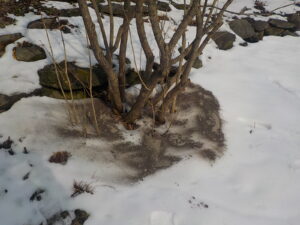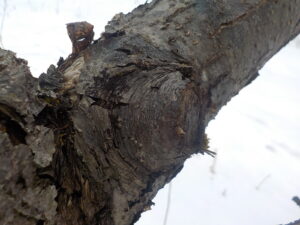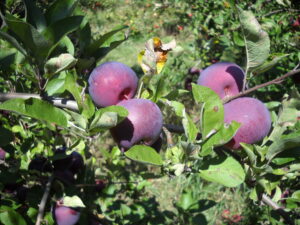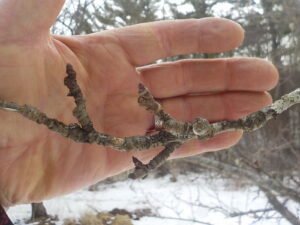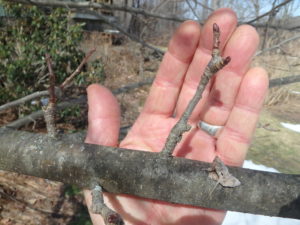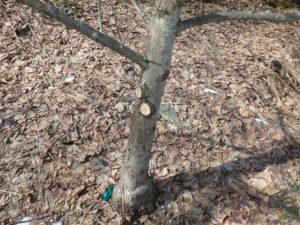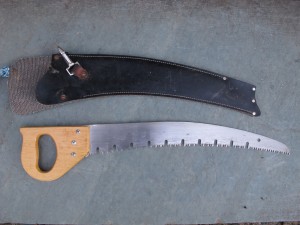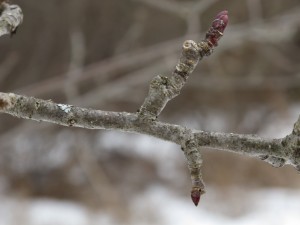March Is a Good Time for Pruning – and More!
Traditionally farmers pruned their fruit trees and put wood ashes around their lilacs in March. And although this is a good time for both, you can do either earlier or later. I believe that because farmers couldn’t plant or work the soil in March, they did other tasks to fill up their days – such as pruning.
What should you remove? First, remove any dead branches. How do you know if the branch is dead, since there are no leaves? The bark will be flakey and a different color from healthy branches. For smaller branches, scrape the bark with your thumbnail. If it does not show green, it is dead. Broken branches should be removed, too.
Often branches grow back towards the middle of the tree. These will create problems as they get larger, often rubbing existing branches and shading out others. So follow them back to their point of origin to remove them. Remove any branches that are rubbing or touching. Decide which is the better branch, and leave it.
When I prune fruit trees, I pay attention to the fruit spurs that actually produce the fruit. When choosing which of two branches to remove, I leave the one that will be producing the most fruit. Fruit spurs are two- to five-inch branches that have buds on them. Fruit spurs produce both leaves and flowers, and need to be at least two years old to on apples and pear trees to produce fruit, sometimes longer.
Pruning Fruit Trees
A well pruned apple tree in full bloom or loaded with fruit is a feast for the eyes. Now is a good time to work on your trees – though you can prune in any month without damaging your tree. Farmers of yesteryear pruned their fruit trees in March, probably because there was no planting and weeding to do. Most orchardists stop pruning when the flowers open in May because working in the tree then will knock off potential fruit.
Before pruning a tree I walk around it a few times, looking at it carefully to determine its basic nature. What shape is it genetically programmed to be? Some trees want to grow lean and tall (particularly pears), others want to develop a thick, dense canopy, and a few seem to like an open, somewhat sparse canopy. Some send up many vertical water sprouts every year, others few. But you can sculpt your tree to be almost anything you want – within reason.
I do insist on a clear trunk up at least 3 or 4 feet from the ground, or even more. This allows me to get to the trunk of the tree to pick fruit, to prune or to mow beneath it. Ideally, low branches are cut off when a tree is small. But if not, start there this year.
Where you make your pruning cut is important for tree health. Don’t cut branches flush to the trunk or a bigger branch. Don’t cut into the swollen area at the base of a branch, an area called the “branch collar”. You can often see a distinct edge to the collar where the wrinkles in the bark in the branch collar stop and smooth bark of the branch begins. But don’t cut off branches too far from the trunk, either. That creates stubs that will die and slowly rot away – leaving an open wound where disease can enter.
Cutting a large branch requires 3 cuts to avoid tearing the bark of the trunk: first, go out the branch a foot or more, and make an undercut. Cut a third of the way through the branch from below. Then move your saw a little farther out the branch and cut down, from the top. Cut right through.
A heavy branch will probably start to drop when you are about half way through the second cut, and the bark will begin to rip. But the undercut will stop the rip, and allow the heavy branch to fall to the ground. Then you can make your third cut near the branch collar.
Remember this: it’s always better to take a few larger branches than 50 smaller ones. And it’s less work, too. Don’t nibble away at your tree like a deer. Be decisive. In any given year you can remove up to 20% to 25% of the (potential) leaves on a tree. Take all dead branches, too, they don’t count. If you rub a branch with your fingernail and you expose a green layer, the branch is alive.
Pruning saws have changed and improved over the years. The bow saw I used as a Boy Scout is outmoded. Tri-cut saws, even relatively small folding saws, are sharp and able to go through wood like termites on speed. Never use a dull or rusty saw. The same goes for your pruners and loppers. Bypass pruners (which work like scissors) are better than anvil-type pruners, which crush branches.
Your goal in pruning is to open up the tree, allowing sunshine to reach every leaf and to allow breezes to promote drying of leaves after a rain or heavy dew. Most fungal diseases thrive when leaves and fruit are constantly wet.
So what to remove? If 2 branches are touching, remove one. If one branch is directly over another, shading it, remove one or the other. Your choice. I look for fruit spurs when deciding which to remove. Fruit spurs are from an inch to 5 inches long and terminate in one or more fat buds. They will open up to multiple flowers and leaves.
I also remove the “dumb branches” – those that instead of reaching out and grabbing sunshine are headed back into the interior of the tree. Not sure why they do that, but they’ve got to go. Darwin would approve.
Not sure if you should remove a branch? Ask yourself what the branch will be like in 5 years, or 10. If it’s going to crash into another branch in a few years, take it out now. And after you’ve removed a big branch, never have second thoughts. In no time others will grow to fill the gap.
For me, pruning is not just about getting the most flowers or fruit from a tree, it’s about creating a beautiful form. In winter, especially, I enjoy looking at a well-pruned tree as sculpture. I prune professionally and love to restore old apple trees. And even though I’m 70 years old, I love to climb to the top of old apple trees, communing with Mother Nature and taking time to enjoy the beauty she has created. I hope I get to keep on climbing trees until the very end of my days.
Read my twice-weekly blog at https://dailyuv.com/
It’s Time To Work On Those Old Apple Trees
I recently spent 3 hours in an old wild apple tree, bringing it new life. Apple trees need to be pruned from time to time, and this one had not been worked on for several years. Even wild apples, those planted by birds, can be wonderful additions to the landscape if nicely pruned. The fruit of wild apples is not tasty, but the flowers and form can be a delight to the eye. You can work on apple trees of any kind from now until the buds begin to open. That isn’t until sometime in May, depending on the weather and the variety you grow.
Before discussing how to prune, a few safety reminders are in order. Always wear eye protection when pruning. Safety glasses are best, but sunglasses or prescription glasses are better than nothing. When cutting branches above your head, wear a cap with a brim and try to stand up-wind of the cut. You don’t want to fill your eyes up with sawdust, especially if on a ladder or perched on an upper branch.
Wear gloves and a long-sleeved jacket. Those will help to protect your skin from cuts if the saw slips. As you finish a cut, slow down and reduce pressure on the blade so that the saw will be less likely to surge forward when it finishes the cut. Never steady yourself by holding onto a branch below what you are sawing. Lastly, use good, sharp tools – a dull saw will be a frustration and can be a danger.
I like to walk around a tree several times to study it before I begin to prune. I want to decide which branches I will take out before I begin. If working with someone (which is always good) I like to hear what my co-worker thinks should be removed.
When I teach pruning I tell people that the goal of pruning is to thin out the canopy so that sunshine can get to each leaf. This will also allow for good air circulation which will help to reduce fungal diseases. I like to say a bird should be able to fly through the tree without getting hurt.
Don’t make cuts flush to the trunk or a larger branch. But don’t leave 3 inch stubs, either. Leave the wrinkled bark where the branch originates. That part is the ‘branch collar’ and it is where the branch will heal and scab over.
The tree I pruned recently was mature but healthy; it had no dead branches or signs of disease. Normally I remove dead wood first.
Next, if 2 branches are rubbing or in danger of fusing together (because they are growing so close together), I remove one of them. On this tree, a four-inch diameter branch was rubbing against and fusing with another, so I removed it in a 2-part procedure. First I reduced the weight of the branch by lopping off most of it. This made the finish cut easier. A heavy branch is likely to snap off and tear the bark before the cut is completed.
It was an awkward cut because the branches were so close together. I used a magic marker to draw lines to show me where to cut. This guided me as I angled the saw up to the exact spot I was aiming for as I completed the cut. I used a 21-inch scimitar-shaped pruning saw for the job. It has big teeth that make the job easier than a smaller saw, and unlike a bow saw, it can get in relatively tight places. It is a Corona brand saw, a model RS 7160that I bought from OESCO, a tool supplier in Conway, MA (www.oescoinc.com).
Branches that are at roughly a 45 degree angle from the leader generally produce the most fruit. Vertical shoots, on the other hand, are not very productive and should be removed. They start out as “water sprouts”, little pencil-sized shoots but will grow to be large if not removed. You should snip them off with hand pruners even though they will reappear next summer. However, if you do a good job of opening up the tree to sunlight, you may get fewer of them.
Blossoms and fruit appear on little fruit spurs, generally 3-4 inch twigs with a few larger buds. Fruit grows on spurs that are at least 3 years old. Each bud will produce more than one blossom and a few leaves. If you take a few branches with fruit spurs and place them in a vase, they will eventually bloom inside the house – a real treat for me. Other buds will just produce leaves, but even those are nice at this time of year.
I removed several large branches in the interior of the tree. It’s always a good plan to make a few cuts of larger branches than lots of little cuts. Don’t think of pruning as “cutting off an arm”. Pruning helps the tree to be healthy and to produce more fruit and flowers in future years.
So have at it. Go outside on a sunny day and start pruning. Take your time. Do the easy stuff first. You’ll gain confidence as you go, and, with time, your tree will turn into a piece of art.
Henry Homeyer’s web sites are www.henryhomeyer.com and www.Gardening-Guy.com.



